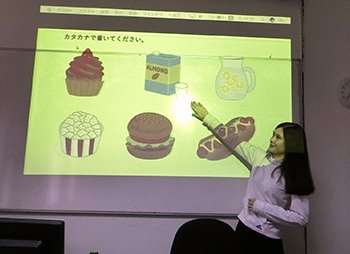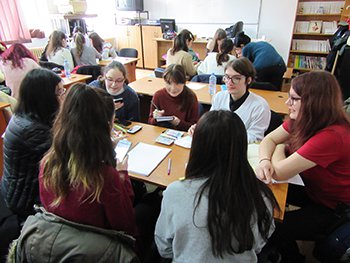2018 Japanese-Language Assistants’ Report: Making Connections
University of Bucharest
TAKEUCHI Tomomi
It has been a year and eight months since I was dispatched to the Japanese Language and Literature Department of the University of Bucharest, Romania, as a Japanese-Language Assistant (hereafter referred to as "Assistant"). I remember a year and eight months ago, finally reaching Romania after almost a full day of travel, as there were no direct flights from Japan. Despite being far away from Japan, there are many students here in Romania who are interested in Japan and are studying Japanese. Here, I teach Japanese-language classes and support out-of-class activities. In the following, I would like to introduce the duties of the Assistant and the circumstance of students studying Japanese at the University of Bucharest.
Japanese Language Classes
The Japanese Language and Literature Department is very popular, with about 50 students enrolling in it each year. As a result, the classroom is always lively. I am in charge of teaching Japanese conversation and Kanji to first-year students for eight hours a week. The students have to graduate in three years, so the classes move at a very fast pace. Even so, they never fail to prepare and review, and I have the impression that many of them are diligent and hardworking. During class, I try to spend as much time as possible interacting with each student, and try to create an atmosphere where each student feels that they are participating proactively, even though there are many of them. Also, in order to encourage students to take as much initiative as possible, from this semester, I have been asking them to create quizzes. The person in charge of the quiz each time makes a lot of effort, and there is a lot I can learn from the students.

A student conducting a quiz
Activities Outside the Classroom
The Japanese Language and Literature Department of the University of Bucharest offers club activities as one of its activities outside of classes. Currently, the following 18 clubs are active.
Ikebana (the Japanese art of flower arranging), tea ceremony, calligraphy, go/shogi, indigo dyeing, drama, karuta (Japanese card game), taiko (Japanese drums), dance, origami, conversation, chorus, kimono wearing, furoshiki (Japanese wrapping cloths), sushi, maid café, picture-story telling, pop culture. In each club, students take the initiative in conducting club activities by passing on to younger students what they have studied in Japan and learned from Japanese people who have come to Bucharest for cultural events. Some students are enrolled in more than one club. I mainly support the activities of the tea ceremony club and the calligraphy club. In both clubs, even though there are very few experienced members, the clubs continue because students learn from the seniors how to handle the equipment and specific details, and then teach that to younger students. I am always amazed at how quickly the students take in what I teach them and, for example, the following week they are already able to do what I taught them the previous week.
Making "Connections"
So far, the Japanese Language and Literature Department of the University of Bucharest has made connections with people of various ages through exchanges with children at the Japanese school, Japanese high school students, Japanese university students, and students from other countries. Among them, I would like to introduce in detail the exchange program with Japanese university students, in which I played a central role.
In late February 2018, 18 university students from Japan visited the University of Bucharest. For the students of the University of Bucharest, the goal was to "create an opportunity to speak Japanese with Japanese people." For the Japanese students, since some of them aim to become Japanese-language teachers in the future, the goal was to "create an opportunity to experience the work of Japanese-language teachers." For students on both sides, it was to "learn a little bit about each other's country and build a relationship that will continue in the future," and we came up with a variety of activities to achieve those goals. First of all, in order to create an opportunity to talk with Japanese people in Japanese, learn a little bit about each other's country, and build a relationship that will continue in the future, we shared videos of self-introductions and customs of our countries in advance through social media. After we met in person, we discussed the cultures of our respective countries and cooked the food of both countries together. Then, students from the University of Bucharest taught Romanian to Japanese students and gave them opportunities to actually use it in markets and other places. In addition, in order to create opportunities for Japanese students to experience the work of Japanese-language teachers, as well as participating in Japanese-language classes, we arranged for them to chat with four teachers who teach Japanese at the University of Bucharest.
The students who participated in the exchange said: "I enjoyed it very much;" "It was so much fun. I will never forget this memory;" "I had the most fun when we cooked;" "It was great fun to cook together." Seeing these comments, the smiles on the students' faces during the exchange, and the tears in their eyes at the end of the exchange, I felt really happy to have done this exchange.
Once you make a connection, I'm sure there will come a day when that connection will come alive again somewhere. Going forward, I would like to continue to increase the number of "connections" that will lead to the future of our students and support them so that they can have various experiences through the Japanese language.

The cultural exchange with Japanese university students
- What We Do Top
- Arts and Cultural Exchange [Culture]
- Japanese-Language Education Overseas [Language]
- Japanese-Language Education Overseas [Language] Top
- Learn Japanese-language
- Teach Japanese-language
- Take Japanese-Language Test
- Know about Japanese-language education abroad
- The Japanese-Language Institute, Urawa
- The Japanese-Language Institute, Kansai
- Japanese-Language Programs for Foreign Specified Skilled Worker Candidates
- Japanese Language Education for Japanese Children Resident Overseas and for the Descendants of Migrants
- Archives
- Japanese Studies and Global Partnerships [Dialogue]
- JF digital collection
- Other Programs / Programs to Commemorate Exchange Year
- Awards and Prizes
- Publications
